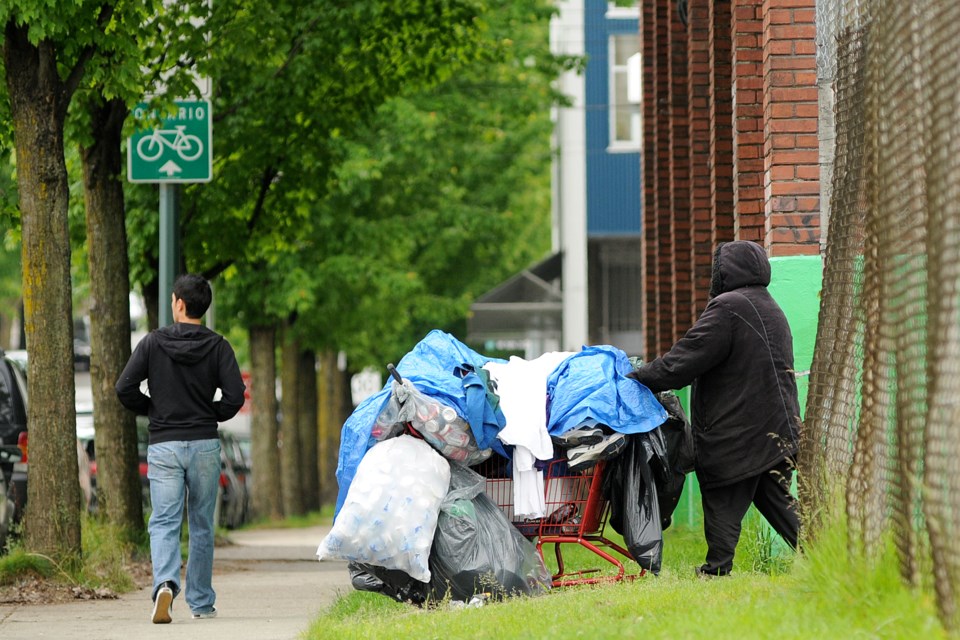The overall homeless population in Vancouver – whether it be on the street or in some form of shelter – has remained fairly steady over the past six years and the latest statistics released Tuesday show 1,746 people are still without a home.
That’s a decrease of 57 people from the 1,803 homeless recorded in a 2014 count. The number of people living on the street dropped from 536 in 2014 to 488 this year, while people residing in a shelter or temporary housing decreased from 1,267 to 1,258.
“We’ve heard some positive news on a 10 per cent drop in street homelessness in our last count in March but the overall level of homelessness remains about the same as in recent years, which is unfortunate given all the investment and housing that’s opened up for people who are vulnerable,” said Mayor Gregor Robertson, whose goal was to end so-called street homelessness by the 2015 count, which was conducted over two days in March. “We obviously need more investment from the provincial and federal governments to ensure we bring the number of homeless people down.”
The mayor and the rest of council heard from Mukhtar Latif, the city’s housing director, that several factors were driving the steady rate of homelessness in Vancouver, including poverty, severe and untreated mental health and addictions, low welfare rates, youth aging out of foster care, a tight rental housing market and prisons and hospitals discharging people to the street and shelters.
Latif pointed out B.C. Housing has a wait list of 4,000 people in Vancouver who want social housing. Vacancy rates in single-room occupancy hotels continue to decline, whereas rents at the hotels continue to increase, surpassing the allotted $375 shelter allowance provided to people on welfare. Shelters are at capacity, with nearly 200 people turned away during this year’s count.
“We’ve got to work across the system to prevent some of the causes of homelessness,” Latif said.
He noted the overall number of homeless people could have surpassed 2,200 in Vancouver this year, had the city and B.C. government not built housing, opened shelters and leased at least four old hotels for temporary housing since last year’s count. That effort opened up 615 total units, with 383 spread over three housing complexes at 1134 Burrard St., 111 Princess St. and 2465 Fraser St.
Key findings of the 2015 count included:
- Of homeless people who agreed to be interviewed by volunteers, 1,057 were men and 356 were women and 15 were transgender.
- Most of the respondents were 25 to 54 years old, with 58 more than 65 years old. At least 12 per cent, or 140, were between the ages of 19 and 24 and another 59 were 18 or younger.
- On the health side, 632 reported an addiction, 508 had a medical condition, 459 were considered mentally ill and 386 had a physical disability.
- More than 400 were on welfare, while 229 said they had a job.
- Aboriginal youth and adults were over represented, with 51 youth and 342 adults.
- Only 49, or five per cent, said they were from outside Vancouver.
Latif released the homeless count report the day after B.C. Housing CEO led the Courier and three other reporters on a tour of government-funded housing and programs in the Downtown Eastside. The province continues to renovate single-room-occupancy hotels and has provided funding for the construction and operation of 14 supportive housing complexes on city property.
All but one of the buildings has opened and Robertson and his Vision colleagues on council are keen to see a second phase of development. Housing Minister Rich Coleman told the Courier Monday that he has yet to see a proposal from the city, to which Vision Coun. Kerry Jang said in council that “I know that we’ve been talking to B.C. Housing about more land being available, I know the mayor, for example, has written Premier Clark and referenced that land being available.”
In a question to Latif, he asked: “Can we make sure that we have a proposal sent directly to the minister, so he cannot say that he never saw it?”
Latif: “Yep, we can do that.”
Jang: “Fantastic, thank you.”
NPA Coun. George Affleck said he was shocked to hear Coleman hadn’t seen a proposal for a second round of development for supportive housing sites. Supportive housing is defined as social housing where tenants have direct access to health care and other services on site.
Affleck said the new homeless statistics indicate to him that Robertson and Vision Vancouver have failed to address homelessness in the eight years the party has ruled city hall. He has noted previously that it was the NPA administration of Sam Sullivan that identified the city properties for development.
When asked what the NPA’s solution is to solve homelessness, Affleck said “we have to work with the province, we have to work with the federal government and we have to work with our neighbours. What is Burnaby doing? What is Richmond doing? What is Surrey doing? What is North Van doing? Not enough.”
Added Affleck: “Vancouver is taking too much of the brunt of this, and I don’t think it’s fair or appropriate for the taxpayers of this city.”
When Vision Vancouver took office in 2008, the count done that year showed there were 1,576 homeless people, with 811 of those living on the street. The lowest number of street homeless recorded occurred in 2011, with 154 counted that March.
The highest homeless population in the city’s history was recorded last year, with 1,803 people counted without a home. It was 628 in 2002.
@howellings



